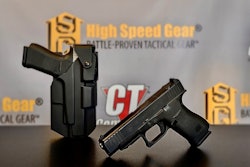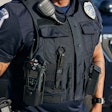![[|CREDIT|]](https://img.policemag.com/files/base/bobit/publicsafety/image/2023/01/pm.killing-americas-gun-industry.jpg?auto=format%2Ccompress&fit=max&q=70&w=400)
This year I attended the Shooting Hunting and Outdoor Trade (SHOT) Show for the first time since January 2020. The 2021 SHOT Show was canceled by the pandemic. My own health concerns prevented me from attending the 2022 show.
A lot has changed in the last few years at SHOT Show. They’ve added more space to the exhibit floor, which was already the size of a small city. More importantly for this article, Remington Arms—founded in 1816—no longer exists. Remington was part of the now defunct Freedom Arms Group, which also included Bushmaster, DPMS Panther Arms, and other familiar brands. Some of these brands have been resurrected by new owners, but the original Remington Arms, a company that launched when America was still in its infancy, is gone. Remington firearms are still being made by a company that formed after the dissolution of the original. The Remington ammo brand is now part of Vista Outdoor.
KILLING REMINGTON
Freedom Arms Group, part of Cerberus Capital Management, is defunct for a variety of reasons. Primarily, it ran up massive debt of nearly a billion bucks. And part of that debt was caused by the defense of a legal campaign waged against the company because a Bushmaster AR-variant rifle was used by the killer during the 2012 Sandy Hook Elementary School massacre in Newtown CT.
Nine of the families whose loved ones were murdered and a teacher who survived filed a lawsuit against Remington Arms (parent of Bushmaster) in 2014. The case was dismissed in 2016 after Remington argued it was immune to such a suit because of the 2005 Protection of Lawful Commerce in Arms Act signed into law by then President George W. Bush. That act gave firearms manufacturers protection from liability based on crimes committed by people using their products.
After the case was dismissed, Remington probably thought it had won. But the plaintiffs’ attorneys found a new angle of attack. They went after the company over how it marketed the Bushmaster AR that was used by the killer. They claimed the marketing was crafted to appeal to young men and glorified its capability for violence. The Connecticut Supreme Court bought that argument and ruled 4-3 in 2019 that the plaintiffs could sue Remington in state court for “unfair trade practices,” regardless of any protection afforded by Congress. The U.S. Supreme Court declined to review that decision, sealing Remington’s fate.
Remington filed for bankruptcy protection in 2018. In 2020, the company ceased to exist after another bankruptcy. At that time, the pieces were sold off. But the matter of the Sandy Hook lawsuit remained. It was settled last year for $73 million.
The campaign against Remington Arms waged by attorneys for the Sandy Hook plaintiffs taught anti-gun groups how to kill firearms manufacturers. If an active shooter uses an AR to slaughter innocent people, file a suit on behalf of the families, and target the gun company’s business practices and marketing.
TARGETING S&W
Two such lawsuits are currently in progress over active shooting attacks from last year. Both were filed by local attorneys with the aid of former New York City Mayor and multi-billionaire Michael Bloomberg’s Everytown for Gun Safety through its litigation arm Everytown Law.
Smith & Wesson is the target of a lawsuit filed on behalf of the victims and the families of the people killed during last year’s Highland Park, IL, parade attack. The shooter used a Smith & Wesson M&P15 to kill seven; 48 people were wounded or injured.
Plaintiff’s counsel argues that Smith & Wesson committed fraud under the state’s Uniform Deceptive Trade Practices Act, just by naming its AR variant rifle “M&P,” which stands for military and police. The gist of the argument is that the M&P15 is not used by the U.S. military. This seems like a specious argument given that the company has used the “Military and Police” name on its products since 1899 and currently uses the M&P branding on a wide variety of pistols and rifles.
The Highland Park lawsuit against Smith & Wesson also claims the company’s M&P rifles should be classified under the National Firearms Act of 1934 as machine guns even though they are semi-automatic because, according to the suit, they can be easily converted to full auto. Under this argument, all semi-auto AR-variant rifles would be Class 3 firearms. This argument is, of course, ridiculous.
As the plaintiff’s attorneys did in the Sandy Hook case against Remington, the Highland Park attorneys are also going after Smith & Wesson for its marketing, claiming the company is encouraging young men to buy its weapons through images similar to video games like “Call of Duty” and with messaging that they say glorifies violence. One such ad had the headline “Kick Brass;” it was for the M&P15-22, a .22 rimfire rifle. To my knowledge from 21 years of reporting on law enforcement, no active shooter has ever used a .22 rimfire AR variant as their primary weapon.
Smith & Wesson has not publicly responded to the Highland Park lawsuit.
DANIEL’S DEFENSE
Daniel Defense, the target of another anti-gun lawsuit triggered by use of a specific weapon by an active shooter, has taken a very different tack. Its CEO Marty Daniel defended the company on LinkedIn. More about that in a minute.In the most horrific active shooter attack this decade, a gunman went to a Uvalde, TX, elementary school and killed 21 kids and staff members. He used a Daniel Defense rifle as the tool for mass murder.
Daniel Defense is named as one of the defendants in a lawsuit filed on behalf of family members of the slain and survivors of the attack. Other defendants named in the multiple lawsuits over the massacre include law enforcement leaders and officers present on the scene during what many have described as an “incompetent and unprofessional response,” city officials, the store that sold the gun, and others.
Once again Everytown Law is involved in conducting the lawsuit, and it is taking a run on turning Daniel Defense into the next Remington. To circumvent the 2005 Protection of Lawful Commerce in Arms Act, the plaintiffs’ attorneys are once again going after the firearms maker for its marketing.
They argue that Daniel Defense falsely implied that its weapons were preferred by the U.S. military by using images of simulated military exercises in its marketing. They claim 90% of DD’s sales are to consumers. They also argued that the company’s provocative social media marketing is reckless and negligent.
In his LinkedIn response to the lawsuit Marty Daniel slammed “gun-grabber” Michael Bloomberg and Everytown for Gun Safety. “This lawsuit is yet another in a growing line of blatant and legally unfounded attempts to bankrupt the firearms industry. We reject and will vigorously defend against these politically motivated attempts to blame Daniel Defense for the criminal actions of others, as well as to undermine your means of self-defense secured by the Second Amendment.” he wrote.
He added, “Michael Bloomberg is the same person who wanted to blame obesity on soda cup size; now he wants to shift blame from the shooter to the firearm manufacturing industry.”
CALL OF DUTY
What’s especially intriguing about the Sandy Hook, Highland Park, and Uvalde lawsuits that target the gun industry is that they don’t go after another company whose products played a big role in the obsessions of the shooters: Activision Blizzard, makers of “Call of Duty.”
In the Uvalde suit, the plaintiff’s attorneys actually argue that part of Daniel Defense’s reckless marketing is to place its products in “Call of Duty,” a video game they say appeals to the violent fantasies of young men. “Games like ‘Call of Duty’ can have an outsized influence on the lives of teenagers, particularly teenagers like the [Uvalde shooter] who are socially isolated and have difficult home lives,” the complaint says. In fact multiple pages of the complaint address the influence of “Call of Duty” in the shooter’s life.
So why isn’t Activision Blizzard named in the lawsuit? After all Daniel Defense has very small pockets compared to the game publisher. (DD is a private company, so its earnings are not publicly released, but there are estimates of under $50 million online.) On “Call of Duty: Modern Warfare” alone, Activision Blizzard raked in nearly $2 billion in revenue. The company’s stock was at $77 a share on the NASDAQ exchange as I wrote this, and it was the target of a Microsoft takeover. If you wanted to do the best for your clients as an attorney, wouldn’t you want to take a run at such a giant.
Probably not. Publishers of first-person shooter video games like “Call of Duty” don’t face the legal challenges of AR-15 manufacturers because the First Amendment is a much tougher legal nut to crack than the Second Amendment. There are anti-gun activist judges; I’ve never heard of an anti-free speech activist judge in contemporary America. Also, as well-funded as Everytown Law is, it might find itself seriously outmatched by the legal staff of a multi-billion dollar corporation. And finally, the reason Activision Blizzard is not named in any of the Everytown Law lawsuits representing victims and survivors of mass shootings is that the game industry is not their target. It is not their goal to destroy the makers of first-person shooter video games. It is their goal to destroy America’s firearms industry, particularly any gun maker who produces AR-15s.
WHAT IT ALL MEANS
So I’m sure you’re asking, “What does all this have to do with law enforcement?”
As I see it two things.
One—and this is a philosophical argument—assigning civil responsibility to a gun company for the acts of active shooters is as Daniel Defense CEO Marty Daniel argues denying the personal responsibility of the shooter. You have to be evil to take a firearm and just start shooting children down in an elementary school. And such evil people will find a way to carry out their plans whether they use knives or guns or homemade explosives. Sure, such killers may be mentally ill, but they are also undeniably evil.
We’ve stopped believing in evil in this country. And that is a major problem for law enforcement. When a guy points a gun at you at a traffic stop and you kill that guy, you get crucified. The suspect was just misunderstood or emotionally disturbed or whatever. But it’s evil to try to kill a cop at a traffic stop. And evil people have to be stopped in order to protect society as a whole.
Second, and this is much more tangible, is that the destruction of some of the nation’s leading firearms companies will make it much more difficult for you and your agencies to purchase guns. The guns will be more expensive, which some people think shouldn’t matter to you, but they don’t realize that many officers in the United States buy their own weapons. This is particularly true for AR variant patrol rifles.
Will the cases against Daniel Defense and Smith & Wesson kill the companies? Probably not. Texas courts will likely grant Daniel Defense immunity based on the Protection of Lawful Commerce in Arms Act. Smith & Wesson faces Illinois courts and that’s a much less gun friendly environment. But even if both companies prevail in the lawsuits, they’re going to spend a lot of money fighting them and fighting the Federal Trade Commission investigations of their marketing practices that Everytown is urging the Biden administration to conduct. So they may have to increase the prices of their guns.
Worse, another victory for Everytown could have a chilling effect on firearms manufacturers and make them think twice about producing AR-variant rifles except under military contract. Fewer ARs on the market would make it much more difficult for law enforcement officers and agencies to buy patrol rifles. And it would make it nearly impossible for consumers to buy modern semi-auto rifles. Which is the ultimate goal of the anti-gun groups bankrolling these lawsuits.

















